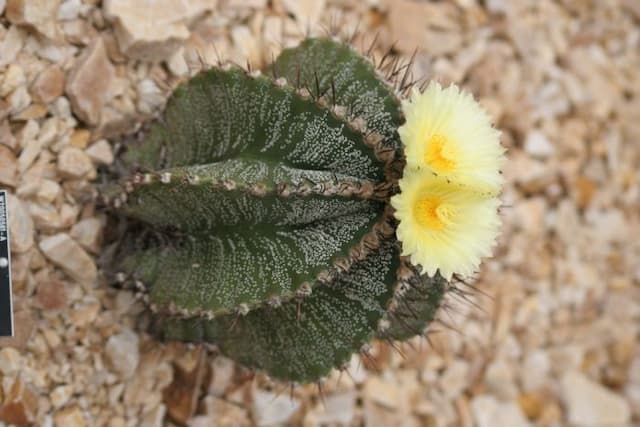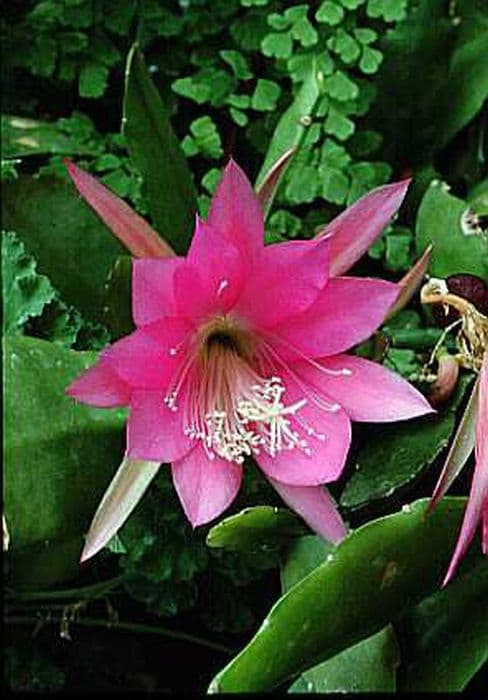Crown Cactus Rebutia glomeriseta

ABOUT
Rebutia glomeriseta, commonly known as Crown Cactus, is a small, globular plant native to high altitudes in South America. It is characterized by its tight clustering habit, with multiple offsets creating a cushion-like appearance. The plant has a lush green color, with the body covered in white, fluffy spines that give it a soft, downy look. These spines also serve to protect the plant from intense sunlight and to collect moisture from the air. The Crown Cactus produces vibrant, funnel-shaped flowers that come in various shades of orange, red, or pink, which contrast beautifully against its green and white background. The flowers typically bloom from the base of the plant or between the clusters, adding an eye-catching pop of color during flowering season. Its overall look is of a dense, woolly clump adorned with occasional bursts of vivid floral hues, making it a popular choice among cacti enthusiasts and a charming specimen in rock gardens and indoor plant collections.
About this plant
 Names
NamesFamily
Cactaceae.
Synonyms
Crown Cactus, Ball Cactus, Orange Snow Ball, White Haired Crown.
Common names
Rebutia glomeriseta.
 Toxicity
ToxicityTo humans
Crown Cactus (Rebutia glomeriseta) is not known to be toxic to humans. Therefore, ingestion of this plant typically does not lead to poisoning or toxic symptoms. However, it is always advisable to avoid ingesting plants that are not meant for consumption, as they may cause an upset stomach or an allergic reaction in sensitive individuals.
To pets
Crown Cactus (Rebutia glomeriseta) is also not known to be toxic to pets. It is not associated with poisoning in animals such as cats and dogs. However, the spines of the cactus can cause physical injury if a pet tries to bite or swallow the plant. While the cactus itself is not poisonous, ingestion can still lead to gastrointestinal upset or blockages due to the indigestible nature and spiny texture of the plant.
 Characteristics
CharacteristicsLife cycle
Perennials
Foliage type
Evergreen
Color of leaves
Varies
Flower color
Mixed
Height
0.1 feet (3 cm)
Spread
0.2 feet (6 cm)
Plant type
Cactus
Hardiness zones
9
Native area
Bolivia
Benefits
 General Benefits
General Benefits- Aesthetic appeal: Rebutia glomeriseta, commonly known as the Crown Cactus, has vibrant flowers that can add a splash of color to homes or gardens.
- Low maintenance: Crown Cactus is suitable for busy individuals as it requires minimal care beyond occasional watering and light requirements.
- Drought-resistant: Being a cactus, it can withstand periods of drought, making it an excellent choice for xeriscaping and water-conservation gardens.
- Compact size: Its small size makes Crown Cactus ideal for windowsills, desktops, and small spaces that cannot accommodate larger plants.
- Educational value: It can serve as a learning tool for children and adults alike to understand the growth and care of succulents and cacti.
- Therapeutic horticulture: The process of caring for it can be calming and stress-relieving, which is beneficial for mental health.
- Habitat support: When grown outdoors, it can provide food through its flowers for pollinators such as bees and hummingbirds.
 Medical Properties
Medical PropertiesThis plant is not used for medical purposes.
 Air-purifying Qualities
Air-purifying QualitiesThis plant is not specifically known for air purifying qualities.
 Other Uses
Other Uses- Rebutia glomeriseta, commonly known as Hedgehog Cactus, can be used as a natural artistic subject for photography enthusiasts, particularly macro photographers, due to its intricate spines and vibrant flowers.
- In terrariums or miniature gardens, the small size and low maintenance of Hedgehog Cactus make it an ideal inhabitant, adding variety and desert-like aesthetics to such arrangements.
- Hedgehog Cactus is often used in educational settings, such as schools and botanical centers, to teach students about plant adaptation, specifically how cacti survive in arid environments with minimal water.
- Due to their compact and rounded shape, Hedgehog Cacti can be used as natural ornaments in desk decor, providing a touch of nature in office environments.
- As a durable and long-living plant, Hedgehog Cactus can be passed down as a living heirloom, representing resilience and growth within families.
- The bright blooms of Hedgehog Cactus can serve as a source of inspiration for artists and designers looking to incorporate natural patterns and colors into their work.
- Hedgehog Cactus can be used in feng shui practices, where they are believed to add "fire" energy to a space due to their spiky appearance and red flowers, thus promoting positive energy flow.
- They are suitable for use in xeriscaping, a landscaping method that reduces the need for irrigation, making them ideal for water-conscious gardens.
- Enthusiasts of model railroading and miniature scenes often use Hedgehog Cacti as realistic flora to enhance the desert landscapes within their setups.
- Cactus collectors may participate in 'cactus swaps' where they trade specimens like Hedgehog Cacti, promoting community and sharing of knowledge about plant care and propagation.
Interesting Facts
 Feng Shui
Feng ShuiThe Crown Cactus is not used in Feng Shui practice.
 Zodiac Sign Compitability
Zodiac Sign CompitabilityThe Crown Cactus is not used in astrology practice.
 Plant Symbolism
Plant Symbolism- Resilience: Rebutia glomeriseta, commonly known as Crown Cactus, is often associated with resilience due to its ability to thrive in harsh, rocky environments with poor soil and intense sunlight.
- Independence: The Crown Cactus requires minimal care and water, symbolizing self-sufficiency and the capacity to stand alone.
- Beauty in Adversity: Despite growing in challenging conditions, the Crown Cactus produces vibrant flowers, representing the idea that beauty can bloom even in tough circumstances.
- Adaptability: As a species that has adapted to extreme conditions, the Crown Cactus is often seen as a symbol of adaptability and the ability to adjust to changing environments.
- Persistence: Its slow growth and long lifespan are emblematic of persistence and the virtues of growing at one's own pace.
 Water
WaterFor the Hedgehog cactus, water approximately every 7-10 days during the active growing season in the spring and summer, allowing the soil to dry out between waterings. In winter, reduce watering to once a month, or whenever the soil is dry to the touch, to reflect the plant's dormant period. When watering, provide enough water to saturate the soil, which typically would be around 8-12 ounces for a small to medium-sized pot. Never let the cactus sit in standing water as it can lead to root rot.
 Light
LightThe Hedgehog cactus thrives in bright, indirect sunlight. It's best positioned in a spot where it can receive several hours of sunlight daily, such as a south or east-facing window. Avoid direct hot summer sun which can scorch the plant. Providing the right amount of light will encourage better flowering and healthy growth.
 Temperature
TemperatureThe Hedgehog cactus prefers temperatures ranging between 50°F and 80°F. It can withstand colder night temperatures down to about 40°F but should not be exposed to frost. The ideal growing conditions include a warm environment during the day and a slight drop in temperature at night.
 Pruning
PruningPruning the Hedgehog cactus is typically not necessary due to its compact growth habit. However, if any dead or damaged spines or plant parts are present, they can be gently removed to maintain a neat appearance. The best time for this light pruning is in the spring, before new growth begins.
 Cleaning
CleaningAs needed
 Soil
SoilCrown Cactus thrives best in a soil mix consisting of equal parts of potting soil, coarse sand, and perlite or pumice to ensure good drainage. The pH should be slightly acidic to neutral, between 6.0 and 7.5.
 Repotting
RepottingCrown Cactus should be repotted every 2 to 3 years or when it outgrows its pot. Repot in the spring or early summer for the best results.
 Humidity & Misting
Humidity & MistingCrown Cactus prefers low to moderate humidity levels; too much humidity can lead to rot.
 Suitable locations
Suitable locationsIndoor
Place in bright, indirect sunlight and keep at room temp.
Outdoor
Outdoor growth requires full sun to partial shade.
Hardiness zone
9-11 USDA
 Life cycle
Life cycleThe Rebutia glomeriseta, commonly known as Crown Cactus, begins its life cycle when seeds germinate in warm, moist soil conditions. Seedlings slowly emerge with small, green, and globular bodies equipped with tiny spines, requiring bright light but protection from intense direct sun. As they mature, these cacti develop into dense clusters of small, round stems, often producing vibrant orange to red flowers in late spring to early summer. Following pollination, which is typically facilitated by insects, the flowers develop into small fruit bearing seeds for the next generation. Over the years, as they reach maturity, Crown Cacti can produce an abundance of flowers annually, while the parent plant continues to grow and may also produce offsets around its base. The plant can live for many years with proper care, experiencing a period of dormancy in cooler winter months which helps initiate the flowering cycle.
 Propogation
PropogationPropogation time
Spring-early summer
Propogation: The Crown Cactus, Rebutia glomeriseta, is generally propagated during its active growth period, which is in the spring and early summer months. The most popular method of propagation for this species is by offsets, which are the small cacti that form at the base of the parent plant. To propagate Crown Cactus by offsets, allow the offset to form a callous for a few days after separating it from the parent plant. Then, plant the offset in a well-draining cactus mix, ensuring the soil is slightly moist. Place the pot in a bright, indirect light area and avoid watering it for a brief period, usually a week, to prevent rot and encourage root development. After the new roots have formed, typically observable in a few weeks, care for the young cactus as you would a mature plant, slowly acclimating it to more direct sunlight.









